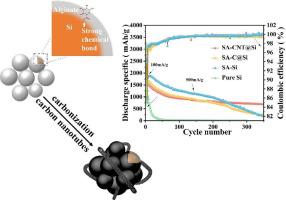当前位置:
X-MOL 学术
›
Sustain. Mater. Technol.
›
论文详情
Our official English website, www.x-mol.net, welcomes your feedback! (Note: you will need to create a separate account there.)
Realization of high-capacity coulombic efficiency in sodium alginate/carbon nanotube double network coated Si-anode for lithium-ion batteries
Sustainable Materials and Technologies ( IF 9.6 ) Pub Date : 2024-04-17 , DOI: 10.1016/j.susmat.2024.e00940 Hongtao Xia , Xiaojiang Mu , Jianhua Zhou , Wenping Liu , Guojing Wu , Feng Dang , Dongmei Zhang , Lei Miao , Haiqing Qin , Zhenjun Zhang , Xiaoxu Lei , Anjun Lu , Zuxue Mo
Sustainable Materials and Technologies ( IF 9.6 ) Pub Date : 2024-04-17 , DOI: 10.1016/j.susmat.2024.e00940 Hongtao Xia , Xiaojiang Mu , Jianhua Zhou , Wenping Liu , Guojing Wu , Feng Dang , Dongmei Zhang , Lei Miao , Haiqing Qin , Zhenjun Zhang , Xiaoxu Lei , Anjun Lu , Zuxue Mo

|
Silicon (Si) is considered as one of the most promising anodes for the next-generation lithium-ion batteries (LIBs) owing to its ultra-high specific capacity, low redox potential and the second abundance of elements in the earth's crust. However, drastic volume change will directly cause electrode pulverization, thus leading to low initial coulombic efficiency (ICE) and terrible cycling stability. In this work, a sodium alginate (SA)‑carbon nanotube (CNT) derived double carbon-coated Si composite (SA-CNT@Si) was prepared through freeze-drying technique followed by high-temperature carbonization, where SA was utilized to encase Si nanospheres, with CNT serving as the conductive framework that interconnects Si spheres. These composites exhibit improved electrical conductivity and stability throughout the charge and discharge cycles when employed as the anodes in LIBs, demonstrating superior electrochemical properties. The SA-CNT@Si electrode with a mass ratio of Si: SA: CNT = 5: 1: 0.75, achieved a first discharge specific capacity of 2200.8 mAh g at a current density of 500 mA g (with the initial three cycles at 100 mA g), along with an ICE of 86.2%. Even after 500 cycles, it maintained a capacity of 607 mAh g. This study presents a novel approach to designing Si-based anode materials characterized by both high electrical conductivity and structural stability.
中文翻译:

海藻酸钠/碳纳米管双网络涂覆锂离子电池硅负极的高容量库伦效率的实现
硅(Si)因其超高的比容量、低氧化还原电位以及地壳中第二丰度的元素而被认为是下一代锂离子电池(LIB)最有前途的阳极之一。然而,剧烈的体积变化会直接导致电极粉化,从而导致初始库仑效率(ICE)低和循环稳定性差。在这项工作中,通过冷冻干燥技术和高温碳化制备了海藻酸钠(SA)-碳纳米管(CNT)衍生的双碳包覆硅复合材料(SA-CNT@Si),其中SA被用来包裹硅纳米球,碳纳米管作为互连硅球的导电框架。当用作锂离子电池阳极时,这些复合材料在整个充电和放电循环中表现出更高的导电性和稳定性,表现出优异的电化学性能。质量比为Si: SA: CNT = 5: 1: 0.75的SA-CNT@Si电极在500 mA g-1电流密度下首次放电比容量达到2200.8 mAh g-1(初始3次循环在100 mA g-1)。 mA g),ICE 为 86.2%。即使经过500次循环后,其容量仍保持在607 mAh g。这项研究提出了一种设计硅基负极材料的新方法,该材料具有高导电性和结构稳定性。
更新日期:2024-04-17
中文翻译:

海藻酸钠/碳纳米管双网络涂覆锂离子电池硅负极的高容量库伦效率的实现
硅(Si)因其超高的比容量、低氧化还原电位以及地壳中第二丰度的元素而被认为是下一代锂离子电池(LIB)最有前途的阳极之一。然而,剧烈的体积变化会直接导致电极粉化,从而导致初始库仑效率(ICE)低和循环稳定性差。在这项工作中,通过冷冻干燥技术和高温碳化制备了海藻酸钠(SA)-碳纳米管(CNT)衍生的双碳包覆硅复合材料(SA-CNT@Si),其中SA被用来包裹硅纳米球,碳纳米管作为互连硅球的导电框架。当用作锂离子电池阳极时,这些复合材料在整个充电和放电循环中表现出更高的导电性和稳定性,表现出优异的电化学性能。质量比为Si: SA: CNT = 5: 1: 0.75的SA-CNT@Si电极在500 mA g-1电流密度下首次放电比容量达到2200.8 mAh g-1(初始3次循环在100 mA g-1)。 mA g),ICE 为 86.2%。即使经过500次循环后,其容量仍保持在607 mAh g。这项研究提出了一种设计硅基负极材料的新方法,该材料具有高导电性和结构稳定性。

































 京公网安备 11010802027423号
京公网安备 11010802027423号